Exploring different aspects of a fictive future vehicle
Different ways to make prototypes and perform tests.
ROLE
UX/UI Designer, Researcher, Workshop facilitator
GOAL
Explore different aspects of a future (fictional) vehicle using prototypes and different methods to perform a test.
DURATION
7 days
Overview
Background
The fictional company Cyberdyne believes that “the modern means of transport” will solve all problems with traffic jams in cities, emissions from old petrol and diesel cars, etc. The flying and electrically powered G-dragon has a massive battery hidden under the saddle. Cyberdyne has not left the lab yet. They know that the product works, and they have tested a lot and tried to go through worst-case scenarios. They know technology, but there is so much they do not know.
The purpose of this project was to create different prototypes and find the best method to test and evaluate the experience.
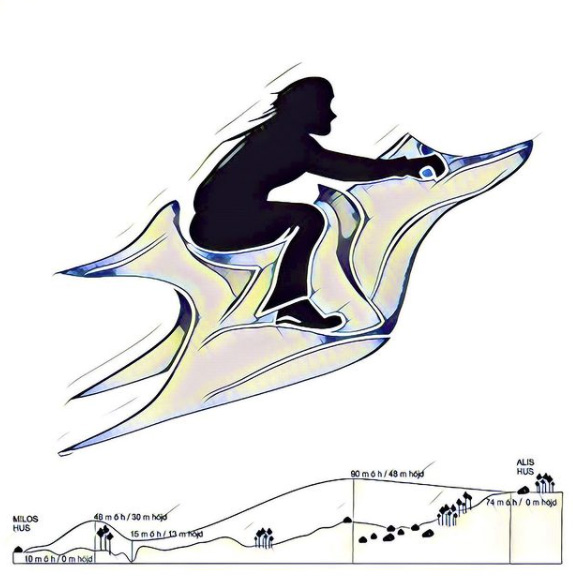
Methods I used in this case:
Usability test
Think aloud
Wizard of Oz
Focus group
Scroll down to see the case!

Create prototype
Explore
To find inspiration, I did secondary research on apps like Volvo on Call, Google Maps, SMHI, and Wayz (see images below). I picked parts of them that I thought could be useful when I created my own interactive prototype in Figma.
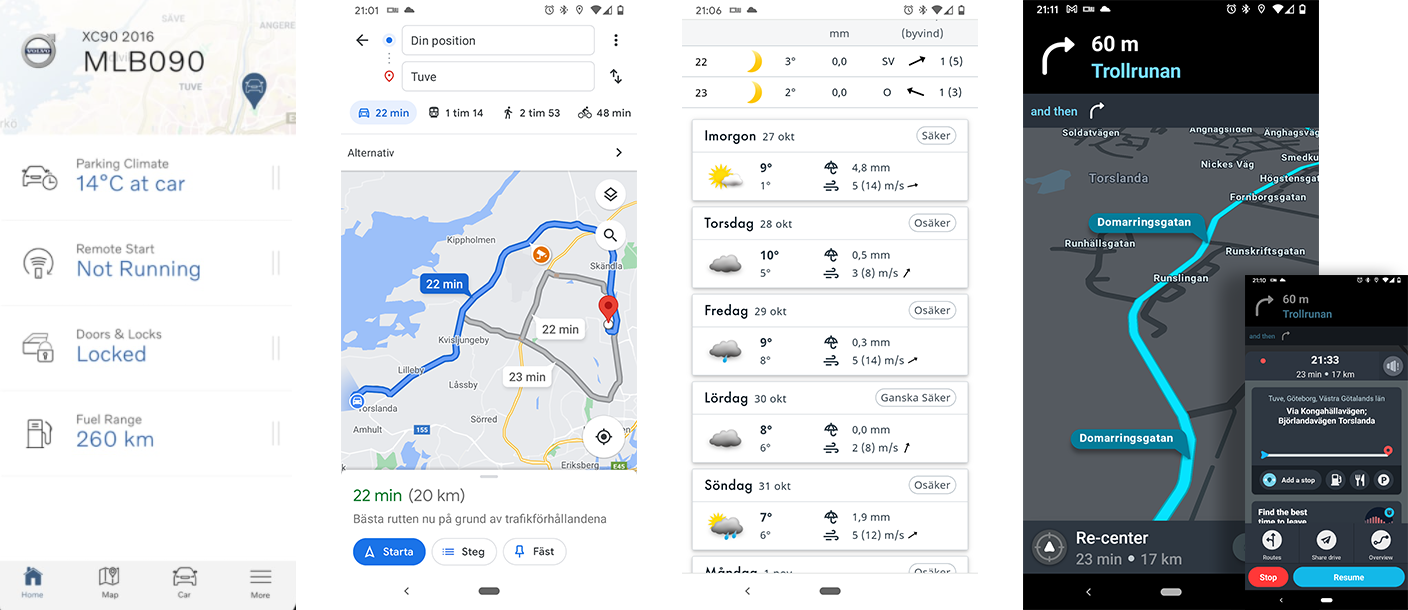
Research findings
I made three major design decisions:
- VEHICLE OVERVIEW for quick status check.
- SPECIFY DESTINATION and get an estimated time of arrival.
- SEE WEATHER to be able to plan the route.
High-fidelity prototype
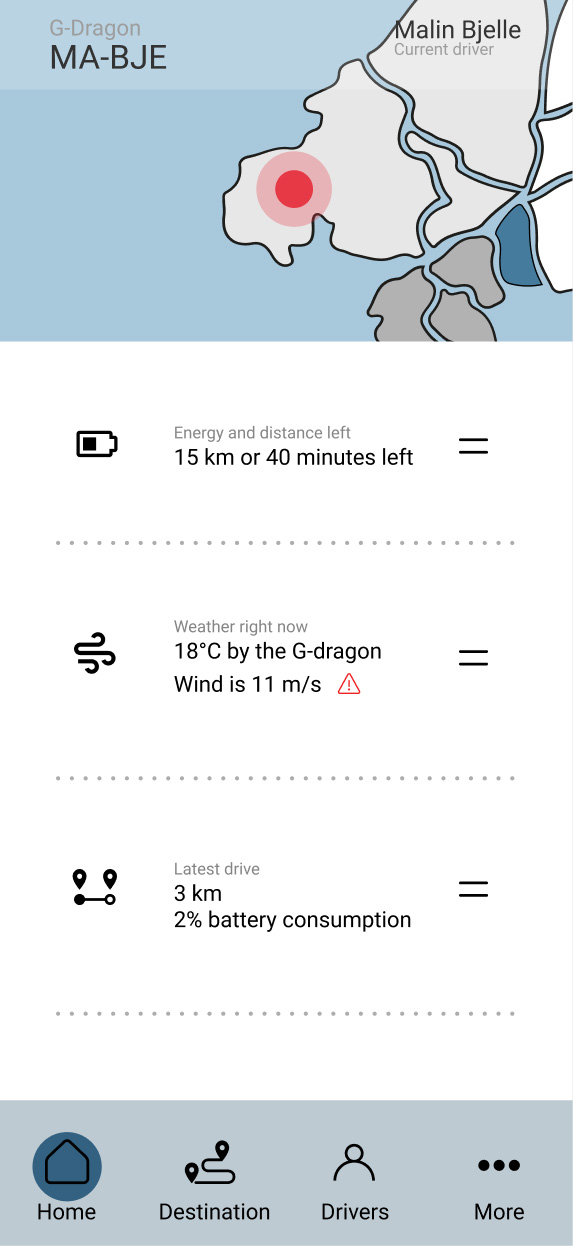
Home menu
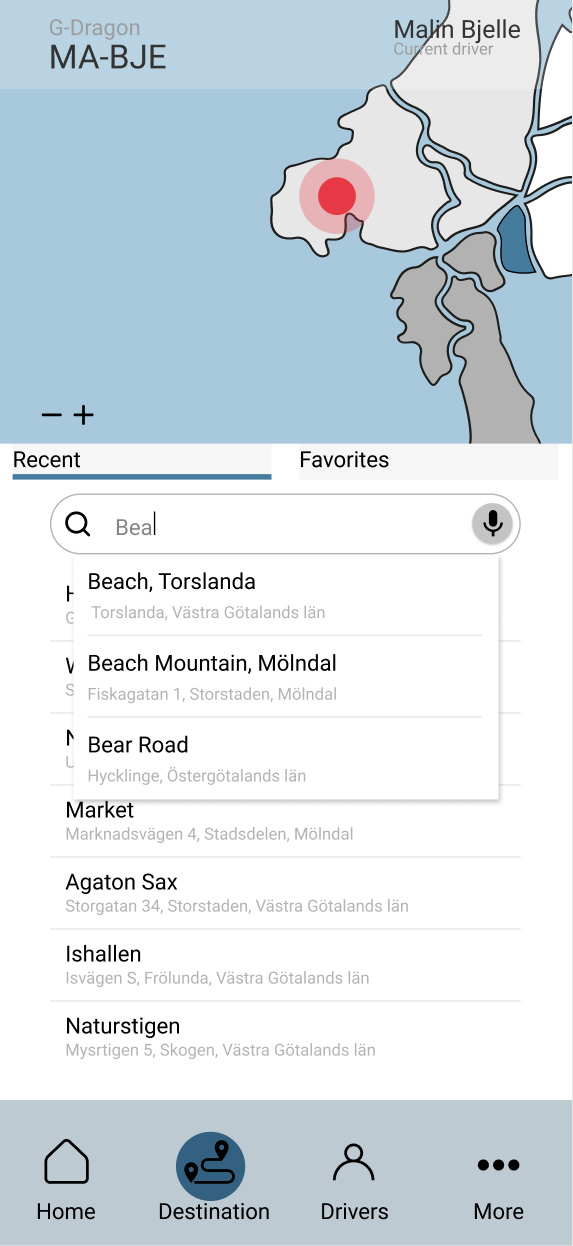
Destination menu
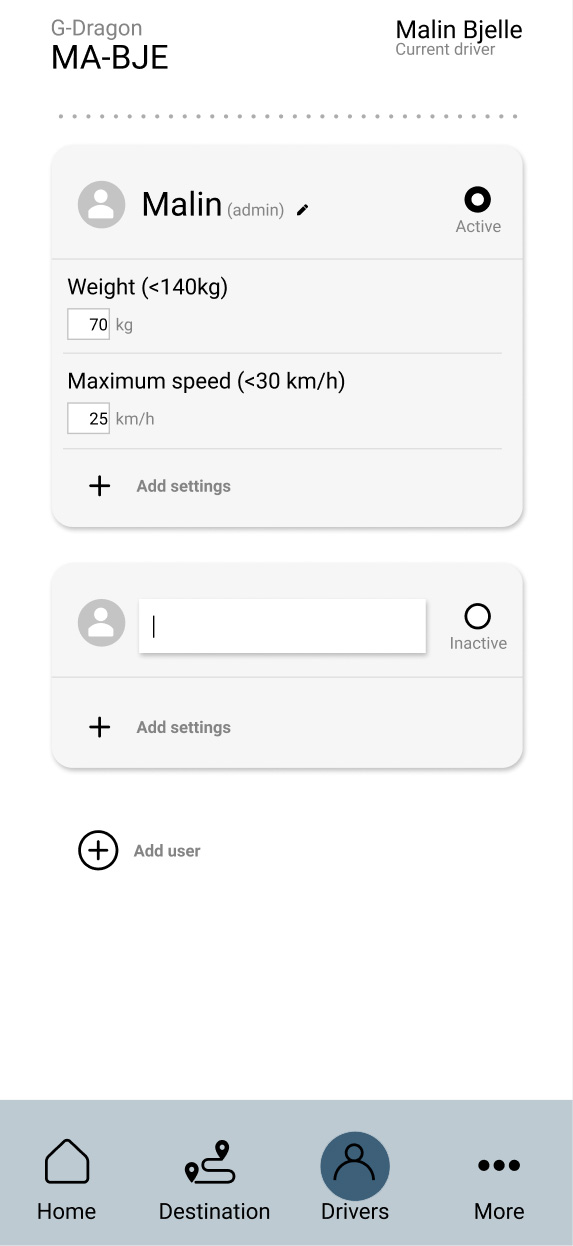
Drivers menu
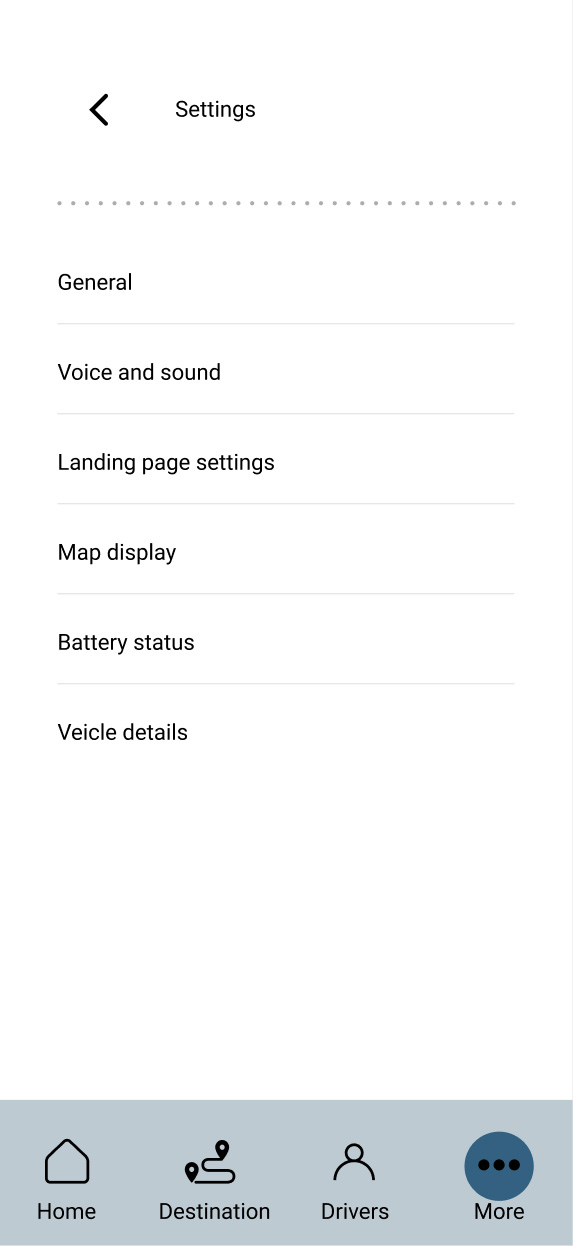
More… menu
Usability test
The target group for this prototype was a potential driver of the vehicle. To evaluate my clickable prototype, I used the following methods:
Think aloud – to understand expectations and actions.
Observation – to see and hear how the test person approached the goal.
Interview – open questions to capture the general experience of the app.
” Is the weather location at my current position or where I am going to?”
“I would like to be able to zoom in on the map!”
Test result
- Easy to navigate.
- Easy to understand
- 24-hour weather information is more relevant than the next 4 days.
- It is hard to understand active and inactive on the Drivers page. “Current driver” is a better name?
- Add zoom function on the map.
- It is unclear which location the weather is displayed. My current location or where I am going?
- Correct spelling.
THINK ALOUD
Communicate critical information through a dashboard
Create prototype
Research and ideation
I wanted to understand how the driver can absorb information without looking directly at the dashboard. Can the driver’s attention be called to the corner of the eye through color and light changes?
I started my research by interviewing a person who works with infotainment systems in cars. I learned that you should show as little information as possible and that this information needs to be clear and not keep the driver’s focus for longer than necessary.
“You should understand the information without looking at it for a long time.”
Sketching
After several sketches, I came up with a proposal that would mainly call the driver’s attention through color and light shifts. That way the driver don’t have to look directly at the screen to get a hint of the vehicle status. Another challenge was the difficult shape of the screen.
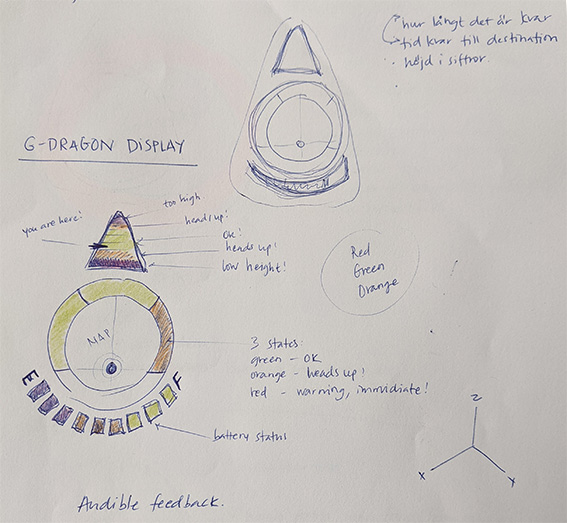
High-fidelity prototype
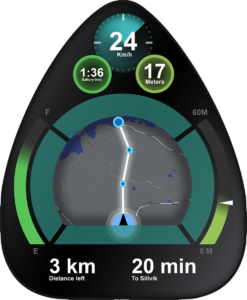
Dashboard prototype, part 1
This version shows a flight session where everything is in order.
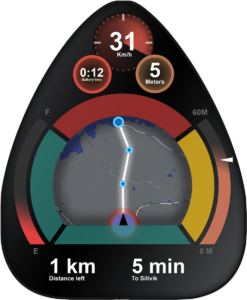
Dashboard prototype, part 2
Red areas indicating warnings: Battery going low, flying at too fast a speed, too low to the ground.
Usability test
The target group for this prototype was a potential driver of the vehicle and I used the same participant as when I tested the mobile app. To evaluate the dashboard prototype I used Think aloud, to understand user’s reactions.
“The battery indicator should be changed to horizontal bars – that is more familiar and people recognize it.”
“The red one was messier, I feel stressed …and triggered!”
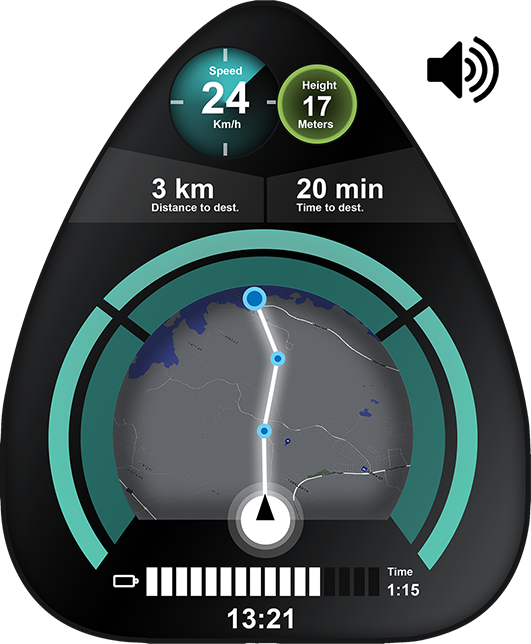
Dashboard adjusted according to feedback.
Create prototype
To create the most realistic feeling, for navigating outdoors with sound, I conducted a Wizard of Oz test. The target group for this prototype was the potential driver and I planned the route before we started but did not inform the driver where he was going. I told him to jump on the bike and pretend it was a flying vehicle.
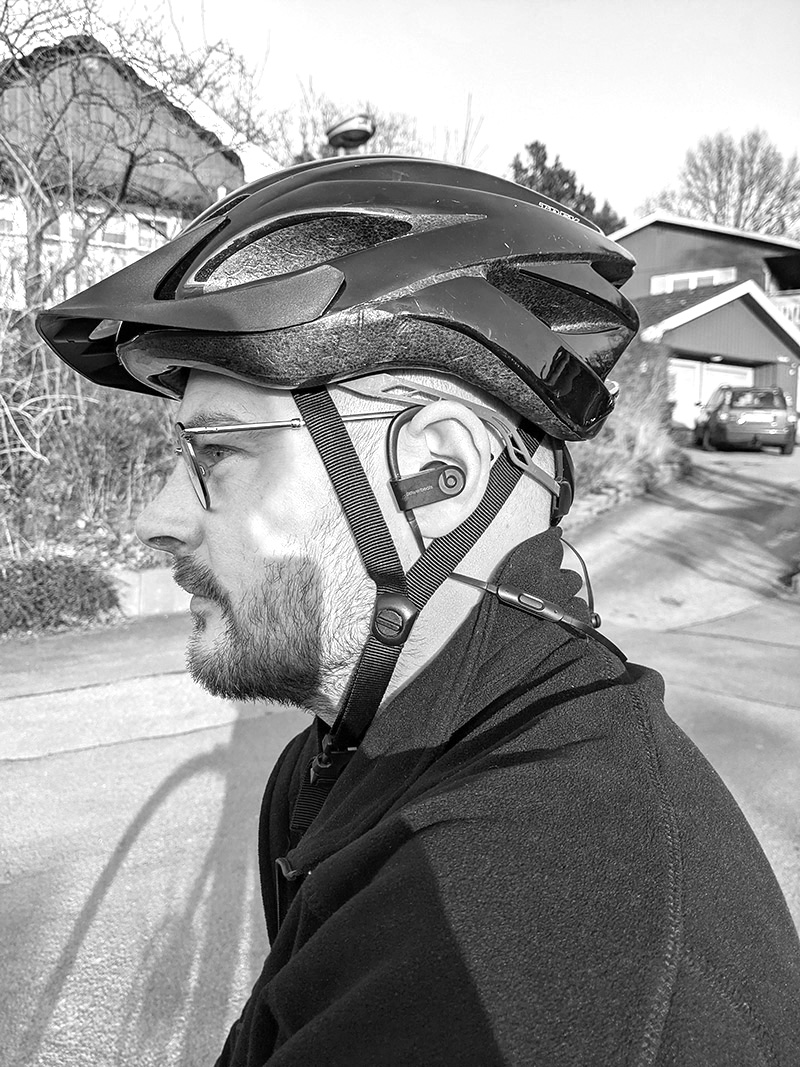
A bike, a helmet and a headset connected to my phone via Bluetooth. I recorded some navigation- and feedback sounds that was played to the driver´s ear.

There was no talk during the test and we kept a speed and distance suitable for me to walk behind the driver.
“Navigating left or right is not relevant when I am up in the air!”
Test result
- It was hard to get the feeling of flying when we rolled along the streets on a bike. I should have had some kind of simulator or biking on a mountain top to get the feeling of height.
- The navigation sounds used the terms right and left to tell the driver where to steer. This is relevant when you are on the ground, but should be expressed in east, west, north and south when you are up in the air.
- “The feedback and confirmation sounds are a bit annoying“, the driver expressed. Maybe it is relevant to make a seperate test to explore this topic. Further, if the vehicle was flying, I wouldn´t have to play the sounds as often due to lack of corners etc.

RESULT:
Red line = planned route.
Blue line = the way my paticipator went by bike.
The blue notes shows where I played the sounds.
FOCUS GROUP
Living with G-Dragon in the society
The target group in this test was people living in a society where G-Dragon is a common means of transport. With a focus group, I was able to explore possibilities and other effects when living in a G-Dragon society. I asked a small group of people, to help me analyze different aspects.
Areas I wanted to explore:
- Can you see any advantages of an alternative means of transport like this?
- Can you see any drawbacks to an alternative means of transport like this?
- Do you think this is something people want?
- What would they be willing to pay?
- What should the form of ownership of a product like this be? Should you rent them out or sell/own them?
- How do you think this new form of transport would affect society?
I built a small community using Duplo and a car mat, to increase the degree of reality. This way my participants could interact and explore situations that may arise.
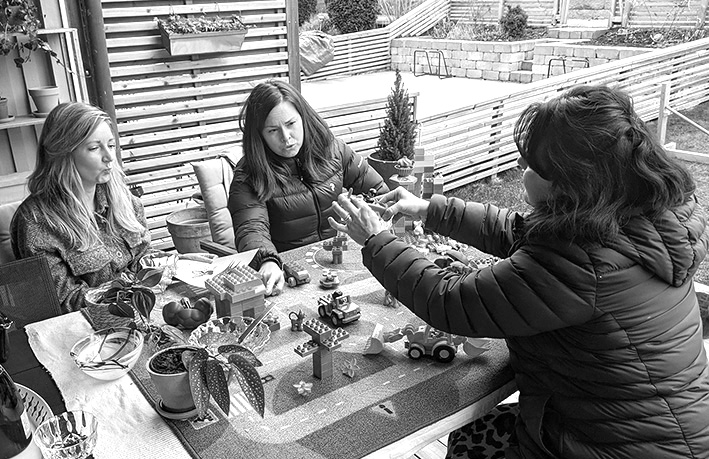

“People will fall from the sky!”
“It does not fit into the cityscape!”
“You could use them as activities linked to nature experiences, as an alternative to helicopters!”
Test result
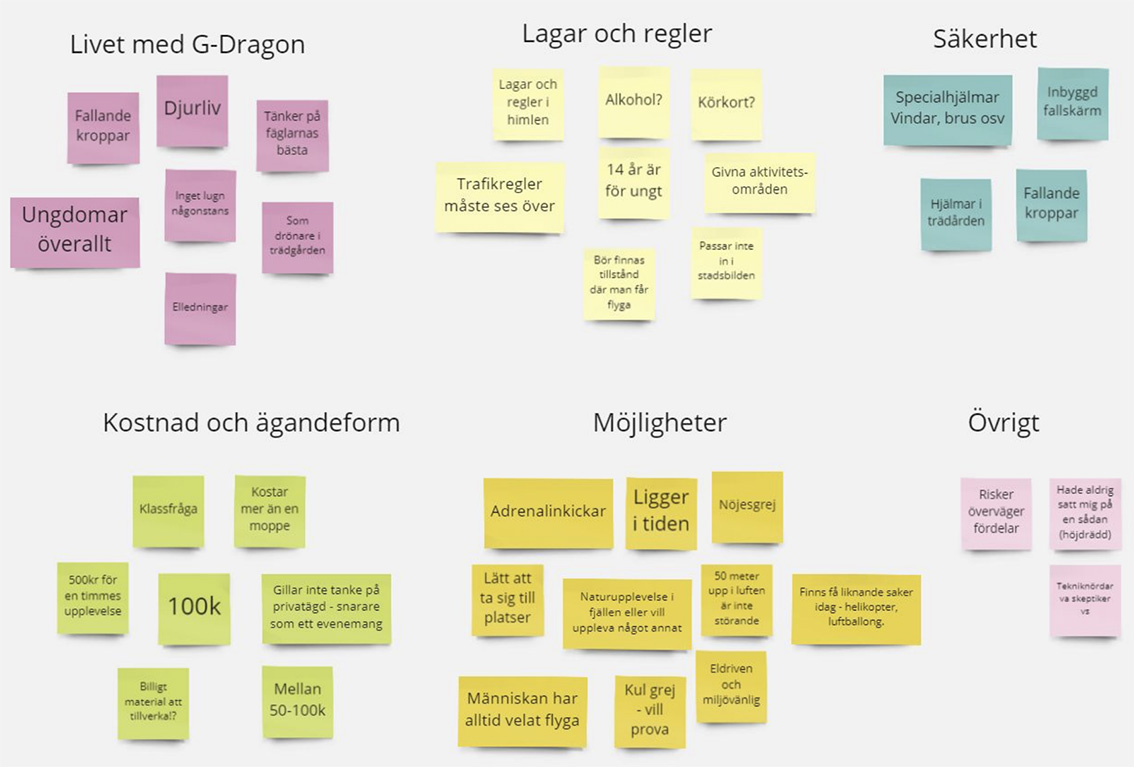
Clustered conclusions from discussions in the group.
Conclusion
This was a great way to experience different prototypes and test it on potential users.
To avoid losing important information and ideas, I should have recorded all events. It is difficult to keep the discussion alive and take notes at the same time.
In the focus group, participants were a bit nervous about being tested. But it was a great way to find focus areas and it becomes a dynamic dialogue when you conduct people in a group. They were all involved in the discussion and thought it was fun!
If there was more time…
#1 I didn´t get the “corner of the eye” reaction from my participants in the dashboard test. I should have had some kind of vehicle to attach the dashboard prototype to. Though the color changes was effective and trigged feelings. It would have been interesting to combine the dashboard prototype with a Wizard of Oz test.
#2 Further explore which navigation sounds to use when G-Dragon is up in the air.
